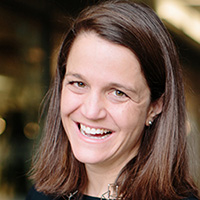Industrialization disrupted the labor of artisans and craftworkers, just as the era of information technology and automation shifted workforce tasks and led to occupational obsolescence.
How will the rapid advance of artificial intelligence (AI) and related technologies impact workers? Which roles will be displaced? How will AI improve and augment work? What valuable new collaborative skills will AI enable?
 To explore these questions, the Northwestern University Center for Human-Computer Interaction + Design (HCI+D) hosted a virtual panel with David Autor, the Rubinfeld Professor of Economics at the Massachusetts Institute of Technology, and Eric Horvitz, chief scientific officer at Microsoft.
To explore these questions, the Northwestern University Center for Human-Computer Interaction + Design (HCI+D) hosted a virtual panel with David Autor, the Rubinfeld Professor of Economics at the Massachusetts Institute of Technology, and Eric Horvitz, chief scientific officer at Microsoft.
Autor and Horvitz are both contributing authors to the National Academies of Sciences’s "Artificial Intelligence and the Future of Work" Consensus Study Report, which assesses the current and future economic, productivity, and workforce impacts of AI across sectors.
 “AI has prompted an unprecedented wave of experimentation, but the future is not inevitable,” said event moderator Liz Gerber, codirector of HCI+D, professor of mechanical engineering at the McCormick School of Engineering, and professor of communication studies in the School of Communication. “We have a role to play, and we can create new forms of valuable and productive work. People are making the decisions, and it’s our obligation to be thoughtful about that.”
“AI has prompted an unprecedented wave of experimentation, but the future is not inevitable,” said event moderator Liz Gerber, codirector of HCI+D, professor of mechanical engineering at the McCormick School of Engineering, and professor of communication studies in the School of Communication. “We have a role to play, and we can create new forms of valuable and productive work. People are making the decisions, and it’s our obligation to be thoughtful about that.”
Complementing human expertise with new modes of collaborative work
Among the 11 key findings of the "Artificial Intelligence and the Future of Work" report, AI is classified as a general-purpose technology — akin to electricity and the steam engine —that has widespread applications and is likely a key driver of long-term economic growth.
While Autor and Horvitz stress the degree of uncertainty around AI’s economic trajectory, they agree that AI will reshape the labor market, albeit unevenly.
AI promises to transform many cognitive tasks across industries, creating new efficiencies. And, while AI might automate or displace certain tasks, it also has the potential to create new roles and forms of work, particularly by complementing human expertise with AI capabilities in decision-making and complex problem-solving. If roles shift such that AI handles repetitive, data-heavy tasks, workers can focus on more creative, interpersonal, and strategic responsibilities.
“What I think AI is most valuable for is supplementing human judgment, particularly in instances when the stakes are high, but there are not clear-cut answers,” Autor said. “Whether it's diagnosing a patient, remodeling a kitchen, or doing some type of skill, repair, or even architecting a piece of software, what AI is really good for is providing guidance and guardrails on how to do that.”
“We've barely scratched the surface on human AI collaborative possibilities,” said Horvitz, who launched Microsoft’s AI Anthology, a collection of essays on the future of AI. “It's such a great area for research right now. We can think deeply about new forms of collaborative work that support the primacy of human agency and contribution.”
In addition to augmenting human expertise more effectively, Autor and Horvitz propose that AI could help more people engage in traditionally specialized fields, such as coding, legal research, and healthcare diagnostics, possibly with less extensive formal training.
In terms of new types of work, Autor and Horvitz warn against a failure of imagination — most technologies are valuable because they enable us to do things that we couldn't do before, not because they enable us to do things better or faster.
“The Apollo Guidance Computer was a little piece of computer hardware with less processing power than the typical modern washing machine,” Autor said. “And yet it got people to the moon.”
Targeting high-impact domains
Autor and Horvitz discussed the transformative potential of sector-specific AI applications in education, healthcare, and frontier science — improving the rate of discovery to tackle grand challenges in medicine, food insecurity, and climate change.
Horvitz is excited about the advancement in the biosciences enabled by AI, from drug discovery and repurposing to predicting the structure and function of proteins to synthesizing new reagents and molecules that will play a role in fighting chronic autoimmune diseases and cancers.
“You build a model that can expand the feasible space of possible candidates much bigger than we've considered in the past,” Horvitz explained. “And then you apply related AI technologies to take that expanded set of possibilities and quickly and efficiently hone it down to candidates that are most likely to have the right properties.”
Horvitz recently collaborated on a project with a team including Northwestern Engineering’s Shana Kelley to design an AI virtual cell, a multi-scale, multi-modal large-neural-network-based model that can simulate the behavior of molecules, cells, and tissues in silico across diverse states.
Looking ahead
Autor and Horvitz advise against a wait-and-see, laissez-faire approach to AI, emphasizing the need for active intervention via policy, governance, incentive structures, and training to proactively direct AI’s future in the labor market.
“We're going to have to rigorously monitor the influences of AI on jobs in the economy and creatively pursue policies to shape the technologies that promote notions of shared prosperity rather than increased economic disparity,” Horvitz said.
Autor quoted his friend, the philosopher Joshua Cohen, who said the future is not a prediction exercise. It is a design exercise.
“We should not just be thinking our job is just to look ahead and say, ‘What's going to happen?’” Autor said. “We're all going to live with the consequences, so we should recognize that we are the people collectively who are making the decisions.”
Supported by Northwestern Engineering and Northwestern’s School of Communication, HCI+D brings together researchers and practitioners from across the University to study, design, and develop the future of human and computer interaction at home, work, and play. In addition to Gerber, the center is co-led by Darren Gergle, Bao Family Professor in Human-Computer Interaction in the School of Communication, and Bryan Pardo, professor of computer science at Northwestern Engineering.
 To explore these questions, the Northwestern University
To explore these questions, the Northwestern University  “AI has prompted an unprecedented wave of experimentation, but the future is not inevitable,” said event moderator
“AI has prompted an unprecedented wave of experimentation, but the future is not inevitable,” said event moderator 


